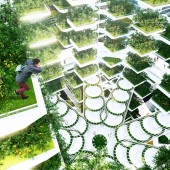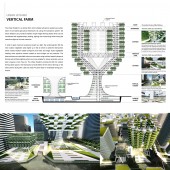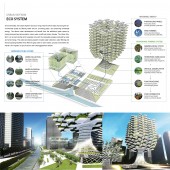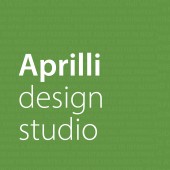Urban Skyfarm - by Aprilli Design Studio |
Home > Winners > #32786 |
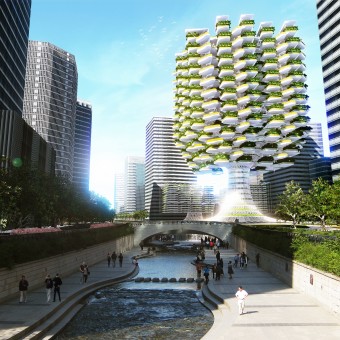 |
|
||||
| DESIGN DETAILS | |||||
| DESIGN NAME: Urban Skyfarm PRIMARY FUNCTION: - INSPIRATION: Inspired by Dr. Dickson Despommier’s original concept of "The Vertical Farm", the Urban Skyfarm is a vertical farm design proposal for a site located in downtown Seoul which mainly hosts local food production and distribution while at the same time contributes to the improvement of local environmental quality through water, air filtration and renewable energy production. UNIQUE PROPERTIES / PROJECT DESCRIPTION: The Urban Skyfarm is a vertical farm design proposal for a site located in downtown Seoul, right adjacent to the Cheonggyecheon stream which is a heavily populated dense urban area within the central business district. Through lifting the main food production field high up in the air, the vegetations gain more exposure toward the natural sunlight and fresh air while the ground level becomes more freed up with nicely shaded open spaces which could be enjoyed by the public. The bio mimicry of the tree form gives many structural and environmental advantages to form a light weight efficient space frame which could host diverse farming activities. The four major components which are the root, trunk, branch and leaf each have their own spatial characteristics which are suitable for various farming conditions. While the upper portions provide open to air farming decks for medium based vegetations, the lower portions enclosed by the structural skin provide more controlled environments for solution based leafy productions. During daytime the photovoltaic panels generate electricity to be used for night time lighting and heating to support farming. The Urban Skyfarm creates a mini ecosystem which brings balance back to the urban community. OPERATION / FLOW / INTERACTION: As a living machine, the tree-like form creates a strong iconic figure in the prominent location and becomes a symbol of well being and sustainable development. Together with the Cheonggyecheon stream, the Urban Skyfarm will become a nice destination place for people seeking for fresh food, air and relaxation within their busy urban life. PROJECT DURATION AND LOCATION: Location: Jung-gu, Seoul, South Korea |
PRODUCTION / REALIZATION TECHNOLOGY: Material: Light weight steel structure with open joint aluminum cladding. System: Medium based Hydroponic System, Solution based Hydroponic System SPECIFICATIONS / TECHNICAL PROPERTIES: Project Height: Sky farm (160m), Hydroponic Farm (45m). Total Area: Sky farm (144,450 m2), Hydroponic Farm (13,350 m2). Program: Hydroponic Farm, Botanic Garden, Viewing Deck, Cafeteria, Farmers Market, Water Filtration Facility, Renewable Energy Production Facility TAGS: Vertical Farm, Skyfarm, Cheonggyecheon, Giant Tree RESEARCH ABSTRACT: By the year 2050, studies show that close to 80% of world’s population will live in urban areas and the total population of the world will increase by 3 billion people. Initiated by Dr. Dickson Despommier’s concept of “The Vertical Farm”, Urban Skyfarm proposes a way to resolve future problems such as land shortage, deforestation and environmental pollution followed by over population. By utilizing hydroponic systems as substitution of soil based agricultural extensions, vertical farms can produce food more efficiently and healthily with supplementary heating, lighting and moisturizing within a controlled environment. As a net zero energy facility, the Urban Skyfarm uses renewable energy produced by solar and wind energy only and saves the overall amount of embodied energy used during the process of production, transportation and distribution of food products. CHALLENGE: The feasibility and profitability is the challenge for vertical farms located within dense urban areas where the land values are high and most lots are preoccupied. The Urban Skyfarm proposes to create an agricultural hub for the local community which hosts social, environmental and economical activities to enhance trade, improve the environment and benefit the local market and community. ADDED DATE: 2014-02-19 22:55:28 TEAM MEMBERS (1) : IMAGE CREDITS: Aprilli Design Studio, 2013. |
||||
| Visit the following page to learn more: http://www.aprilli.com | |||||
| AWARD DETAILS | |
 |
Urban Skyfarm-by Aprilli Design Studio is Winner in Futuristic Design Category, 2013 - 2014.· Read the interview with designer Aprilli Design Studio for design Urban Skyfarm here.· Press Members: Login or Register to request an exclusive interview with Aprilli Design Studio. · Click here to register inorder to view the profile and other works by Aprilli Design Studio. |
| SOCIAL |
| + Add to Likes / Favorites | Send to My Email | Comment | Testimonials | View Press-Release | Press Kit |
Did you like Aprilli Design Studio's Futuristic Design?
You will most likely enjoy other award winning futuristic design as well.
Click here to view more Award Winning Futuristic Design.


